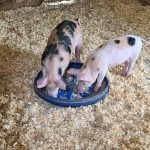With pressure from media, company buyers changed minds
In an agriculture that is rapidly evolving, these three Quebec farms have found innovative ways to diversify, to access markets and to make farming attractive to the next generation
Jean-Luc Baril: potatoes for the North
Direct sales to your customers may always be a good strategy, especially when you are a produce farmer. But what if you don’t farm in the suburbs? What if you farm in an isolated, northern and sparsely populated region?
Read Also

A new spin on farm legacy
What does farm legacy look like for the next generation.
Jean-Luc Baril created his own solution. First, Baril says, get everyone on your side. Then ask local supermarkets to sell local products first.
If it sounds like dreaming, the results are very real. Today, Baril’s potatoes are sold in every supermarket in Abitibi-Témiscamingue, the northern frontier of Quebec’s agriculture, forestry and mining industries.
That’s a complete reversal from three years ago. Then, some of Baril’s potatoes would find their way into local supermarkets, but only after they made a 1,350-km round trip to Montreal’s supermarket chain warehouses and back.
With help from neighbouring farmers, Baril started his campaign by making politicians and journalists aware of how ridiculous that round trip really was.
Media reports are what made the difference, Baril now says. How could supermarket executives face the public and justify importing potatoes when they are grown next door?
Baril finally got the phone call that changed the fate of his business. The following week, he was supplying just about all supermarkets in Abitibi-Témiscamingue. He now delivers twice a
With at-home beef processing and store sales, two sons can now stay on the farm
week on a 342-km circuit, with a 53-foot tractortrailor bearing the wording “We have our local products at heart.”
Baril’s van also carries eggs, cheese and chocolate made in villages next to Saint-Eugne-de-Guigues, where he milks 46 Holsteins that eat the rejects from his 8,000-ton-per-year potato production.
“Consumers have responded very well,” Baril says. “Buyers had estimated they would need 25 or 26 pallets per week. We are now up to 40.”
One consequence of securing the regional market is that Baril now has to provide the full category of potatoes, including whites, reds and yellows. He also now sells more five-pound bags, a format that is more profitable than the 10-pound bags he ships to Montreal.
Baril also sells to a distributor that serves supermarkets in all of northern Ontario, as well as to mine sites all the way to Manitoba, plus dam construction sites run by Hydro-Quebec.
“Sometimes,” jokes Baril, “it’s good to be located so far away!”
The Raymonds:
It’s 9 a. m. on a Wednesday morning at Montreal’s Jean-Talon Market. Mathieu Raymond is unloading beef from his truck while employees fill the refrigerated counters at Ferme du Nordest.
Rising at 4:30 a. m. and driving 225 km south to Montreal once a week is only part of the price that Mathieu Raymond, 23, pays to be part of his parents’ business.
Cattle farming isn’t any more of a moneymaker in Quebec these days than it is anywhere else in Canada. As in the rest of Canada too, if you’re looking to find young people getting into beef farming, you better be prepared to look long and hard.
Even so, Roger Raymond and his wife Céline Bélec still think there’s a future on the farm for their two sons. That’s why they’ve decided to go into processing and marketing.
In the basement of the new farmhouse, they have built a modest meat-processing and packaging plant, where their son Mathieu and employees spend long hours processing a lot more than the farm’s own hormone-free Angus calves.
Chicken, pork and lamb from partner farms are also cut, seasoned and packaged, to be sold under the Ferme du Nordest brand name.
Buying, processing and marketing meat from other farms is one of the solutions the Raymonds have found to make their business profitable. Concentrating sales at a limited number of high-performing outlets is also part of the strategy.
The farm’s gluten-free sausages were a hit right from the start. The family would sell up to 14 coolers of sausages in a morning at seasonal weekly farmers’ markets. But tending a booth at an outdoor market is tedious and sometimes exasperating, especially when the weather is perfect for a hay crop.
During a visit at the Jean-Talon Market, a friend of Céline Bélec convinced her to apply for permanent space at Montreal’s most renowned outdoor and indoor market. The big city is a scary place, Bélec first thought. On the other hand, though, wouldn’t it be a relief if she no longer had to run from one seasonal farmers’ market to the next?
As it turns out, Montrealers love Ferme du Nordest’s “natural” meats. “It tastes like real meat, just like when I was young,” some say. The farm’s products are also sold directly to a few restaurants and specialty food shops, and last year, Ferme du Nordest opened its own butcher shop in Saint-Sauveur.
The work is hard, but it’s all worth it, Bélec says. “When a client tells us the meat they had was exceptionally good, it’s worth a month’s salary to us.”
making lifestyle pay
Out go the pigs, in come the chickens. In the hilly countryside of the Beauce region, south of Quebec City, the Berthiaume family makes business decisions with two criteria in mind: profitability and quality of life.
Most importantly, Mario Berthiaume, his wife Solange and his brother Marco, are making choices with the goal of ensuring that farming will be just as enjoyable for the next generation as it has been for them.
making lifestyle pay
Out go the pigs, in come the chickens. In the hilly countryside of the Beauce region, south of Quebec City, the Berthiaume family makes business decisions with two criteria in mind: profitability and quality of life.
Most importantly, Mario Berthiaume, his wife Solange and his brother Marco, are making choices with the goal of ensuring that farming will be just as enjoyable for the next generation as it has been for them.
Dairy and hog farming had gone hand in hand on their farm until the latest crisis in the pork industry. When hogs were paying well, they used the money to improve milk production. When losses came along, the stable revenues from milk helped keep the farm afloat.
Last year, when disease hit two farrowing houses, Mario decided it was time to invest in an old dream and get into chicken production. The two buildings were converted into broiler production units and quota was purchased.
Mario’s son, Yan, agreed with the move. “Chicken production goes along very well with milk production. I spend only about an hour per day checking on the birds, at the time that’s convenient for me.”
One thing’s clear to Mario Berthiaume. In animal production, there’s only a future in supply management. “In pork and beef,” he says, “no young farmers are stepping in.”
Instead, with an enterprise mix based on supply-managed commodities, the family can look at the future as a series of opportunities, figuring out how best to transfer the farm to the next generation.
The plan is for Yan, 25, and his brother Alex, 19, to tailor their farm to their individual tastes. They could get rid of the remaining swine if they want. One could take the chickens, the other one the dairy cows. The family’s sugar shack might just remain a family affair. The feed mill that also serves an uncle’s farms could be operated as a joint venture.
When the parents retire, their hobby will be Les Encans Sélectgnes, the auction service they set up in the aftermath of the BSE crisis so that farmers could have fast access to good-quality cows to fill their quota.
One could say the Berthiaumes are all over the place, without a sharp business focus. It’s true that profit is not what motivates them. They’d rather invest in the future, and have fun at farming. “If you can’t enjoy your work,” asks Solange, “how else are you supposed to work?” CG
Dairy and hog farming had gone hand in hand on their farm until the latest crisis in the pork industry. When hogs were paying well, they used the money to improve milk production. When losses came along, the stable revenues from milk helped keep the farm afloat.
Last year, when disease hit two farrowing houses, Mario decided it was time to invest in an old dream and get into chicken production. The two buildings were converted into broiler production units and quota was purchased.
Mario’s son, Yan, agreed with the move. “Chicken production goes along very well with milk production. I spend only about an hour per day checking on the birds, at the time that’s convenient for me.”
One thing’s clear to Mario Berthiaume. In animal production, there’s only a future in supply management. “In pork and beef,” he says, “no young farmers are stepping in.”
Instead, with an enterprise mix based on supply-managed commodities, the family can look at the future as a series of opportunities, figuring out how best to transfer the farm to the next generation.
The plan is for Yan, 25, and his brother Alex, 19, to tailor their farm to their individual tastes. They could get rid of the remaining swine if they want. One could take the chickens, the other one the dairy cows. The family’s sugar shack might just remain a family affair. The feed mill that also serves an uncle’s farms could be operated as a joint venture.
When the parents retire, their hobby will be Les Encans Sélectgnes, the auction service they set up in the aftermath of the BSE crisis so that farmers could have fast access to good-quality cows to fill their quota.
One could say the Berthiaumes are all over the place, without a sharp business focus. It’s true that profit is not what motivates them. They’d rather invest in the future, and have fun at farming. “If you can’t enjoy your work,” asks Solange, “how else are you supposed to work?” CG














